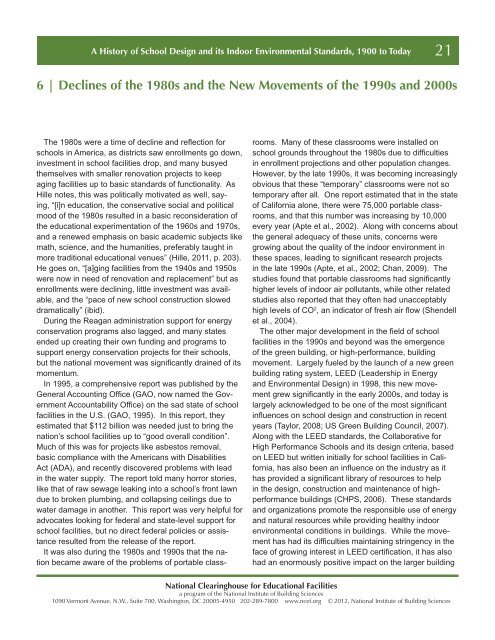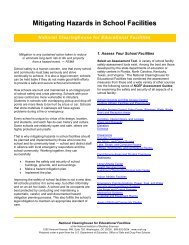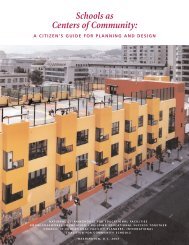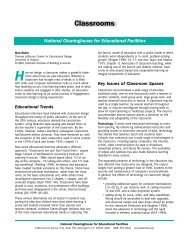A History of School Design and its Indoor - National Clearinghouse ...
A History of School Design and its Indoor - National Clearinghouse ...
A History of School Design and its Indoor - National Clearinghouse ...
Create successful ePaper yourself
Turn your PDF publications into a flip-book with our unique Google optimized e-Paper software.
A <strong>History</strong> <strong>of</strong> <strong>School</strong> <strong>Design</strong> <strong>and</strong> <strong>its</strong> <strong>Indoor</strong> Environmental St<strong>and</strong>ards, 1900 to Today<br />
6 | Declines <strong>of</strong> the 1980s <strong>and</strong> the New Movements <strong>of</strong> the 1990s <strong>and</strong> 2000s<br />
The 1980s were a time <strong>of</strong> decline <strong>and</strong> refl ection for<br />
schools in America, as districts saw enrollments go down,<br />
investment in school facilities drop, <strong>and</strong> many busyed<br />
themselves with smaller renovation projects to keep<br />
aging facilities up to basic st<strong>and</strong>ards <strong>of</strong> functionality. As<br />
Hille notes, this was politically motivated as well, saying,<br />
“[i]n education, the conservative social <strong>and</strong> political<br />
mood <strong>of</strong> the 1980s resulted in a basic reconsideration <strong>of</strong><br />
the educational experimentation <strong>of</strong> the 1960s <strong>and</strong> 1970s,<br />
<strong>and</strong> a renewed emphasis on basic academic subjects like<br />
math, science, <strong>and</strong> the humanities, preferably taught in<br />
more traditional educational venues” (Hille, 2011, p. 203).<br />
He goes on, “[a]ging facilities from the 1940s <strong>and</strong> 1950s<br />
were now in need <strong>of</strong> renovation <strong>and</strong> replacement” but as<br />
enrollments were declining, little investment was available,<br />
<strong>and</strong> the “pace <strong>of</strong> new school construction slowed<br />
dramatically” (ibid).<br />
During the Reagan administration support for energy<br />
conservation programs also lagged, <strong>and</strong> many states<br />
ended up creating their own funding <strong>and</strong> programs to<br />
support energy conservation projects for their schools,<br />
but the national movement was signifi cantly drained <strong>of</strong> <strong>its</strong><br />
momentum.<br />
In 1995, a comprehensive report was published by the<br />
General Accounting Offi ce (GAO, now named the Government<br />
Accountability Offi ce) on the sad state <strong>of</strong> school<br />
facilities in the U.S. (GAO, 1995). In this report, they<br />
estimated that $112 billion was needed just to bring the<br />
nation’s school facilities up to “good overall condition”.<br />
Much <strong>of</strong> this was for projects like asbestos removal,<br />
basic compliance with the Americans with Disabilities<br />
Act (ADA), <strong>and</strong> recently discovered problems with lead<br />
in the water supply. The report told many horror stories,<br />
like that <strong>of</strong> raw sewage leaking into a school’s front lawn<br />
due to broken plumbing, <strong>and</strong> collapsing ceilings due to<br />
water damage in another. This report was very helpful for<br />
advocates looking for federal <strong>and</strong> state-level support for<br />
school facilities, but no direct federal policies or assistance<br />
resulted from the release <strong>of</strong> the report.<br />
It was also during the 1980s <strong>and</strong> 1990s that the nation<br />
became aware <strong>of</strong> the problems <strong>of</strong> portable class-<br />
<strong>National</strong> <strong>Clearinghouse</strong> for Educational Facilities<br />
a program <strong>of</strong> the <strong>National</strong> Institute <strong>of</strong> Building Sciences<br />
1090 Vermont Avenue, N.W., Suite 700, Washington, DC 20005-4950 202-289-7800 www.ncef.org © 2012, <strong>National</strong> Institute <strong>of</strong> Building Sciences<br />
21<br />
rooms. Many <strong>of</strong> these classrooms were installed on<br />
school grounds throughout the 1980s due to diffi culties<br />
in enrollment projections <strong>and</strong> other population changes.<br />
However, by the late 1990s, it was becoming increasingly<br />
obvious that these “temporary” classrooms were not so<br />
temporary after all. One report estimated that in the state<br />
<strong>of</strong> California alone, there were 75,000 portable classrooms,<br />
<strong>and</strong> that this number was increasing by 10,000<br />
every year (Apte et al., 2002). Along with concerns about<br />
the general adequacy <strong>of</strong> these un<strong>its</strong>, concerns were<br />
growing about the quality <strong>of</strong> the indoor environment in<br />
these spaces, leading to signifi cant research projects<br />
in the late 1990s (Apte, et al., 2002; Chan, 2009). The<br />
studies found that portable classrooms had signifi cantly<br />
higher levels <strong>of</strong> indoor air pollutants, while other related<br />
studies also reported that they <strong>of</strong>ten had unacceptably<br />
high levels <strong>of</strong> CO 2 , an indicator <strong>of</strong> fresh air fl ow (Shendell<br />
et al., 2004).<br />
The other major development in the fi eld <strong>of</strong> school<br />
facilities in the 1990s <strong>and</strong> beyond was the emergence<br />
<strong>of</strong> the green building, or high-performance, building<br />
movement. Largely fueled by the launch <strong>of</strong> a new green<br />
building rating system, LEED (Leadership in Energy<br />
<strong>and</strong> Environmental <strong>Design</strong>) in 1998, this new movement<br />
grew signifi cantly in the early 2000s, <strong>and</strong> today is<br />
largely acknowledged to be one <strong>of</strong> the most signifi cant<br />
infl uences on school design <strong>and</strong> construction in recent<br />
years (Taylor, 2008; US Green Building Council, 2007).<br />
Along with the LEED st<strong>and</strong>ards, the Collaborative for<br />
High Performance <strong>School</strong>s <strong>and</strong> <strong>its</strong> design criteria, based<br />
on LEED but written initially for school facilities in California,<br />
has also been an infl uence on the industry as it<br />
has provided a signifi cant library <strong>of</strong> resources to help<br />
in the design, construction <strong>and</strong> maintenance <strong>of</strong> highperformance<br />
buildings (CHPS, 2006). These st<strong>and</strong>ards<br />
<strong>and</strong> organizations promote the responsible use <strong>of</strong> energy<br />
<strong>and</strong> natural resources while providing healthy indoor<br />
environmental conditions in buildings. While the movement<br />
has had <strong>its</strong> diffi culties maintaining stringency in the<br />
face <strong>of</strong> growing interest in LEED certifi cation, it has also<br />
had an enormously positive impact on the larger building










